The What, How and Why of Customer Journey Maps
In our consumer-centric world, providing a superior customer experience takes priority for those brands pursuing real success. It’s no great surprise that businesses today are going the extra mile to better understand their customers.
Whether your brand is B2B or B2C; a start-up or corporation; global or local, providing exceptional customer experience (CX) is no easy feat. So, what better way to get to know your elusive audience than by walking in their shoes and mapping each and every interaction that you share.
This is where Customer Journey mapping (CJM) comes in.
You may be wondering, can mapping the actions and experiences of my customers really have that much of a strong impact? Simply, yes. But sit tight, we’ll get to that part later on.
First, let’s get back to basics...
What is customer journey mapping?
A customer journey map is a visualisation of an end-to-end customer experience. It’s essentially a visual narrative that allows you to comprehend each process that your customer encounters with your brand, spanning each step from the initial engagement to, hopefully, a long-term relationship.
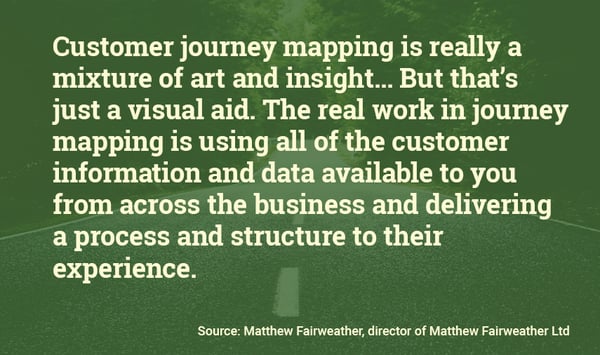
Customers today are active participants in the market process. Gone are the days where brands and marketers would simply push products and messages in the hope of gaining any traction from, well, anyone at all. Now, personalisation is rife; consumers know what they want and they staunchly assume that brands will know this, too. Customers also have the ability and confidence to communicate with brands across multiple channels and let them know where their dissatisfaction lies.
The prevalence of personalisation that we see in today’s marketplace can be attributed to brands’ use of clever market segmentation. Because of this, consumers now expect personalised experiences and messages with value. And they will not be satisfied unless they receive bespoke products and interactions.
In order to facilitate those great products, services and multi-channel communications that you’ve been striving for, you need to first figure out your user. And customer journey mapping (CJM) is a surefire way of achieving this.
But before we delve into the benefits of CJM, or the actions and research that brands must meet in order to create an effective customer journey map, let’s take a look at what a healthy journey map looks like:
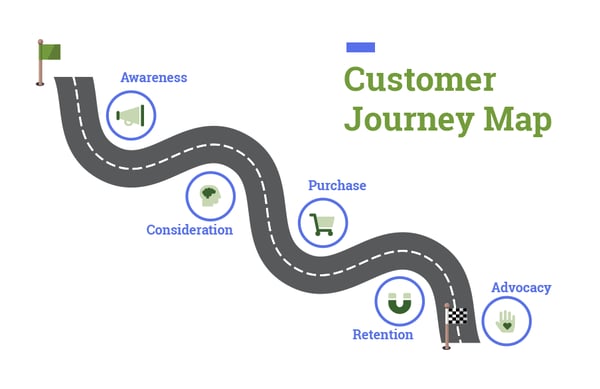
You can see from the above graphic that a journey map generally spans 5 aspects:
Awareness → Consideration → Purchase → Retention → Advocacy
Your CJM details each experience that your customer has with you over time. So it’s important to ascertain each action or decision that’s made, as each occurrence has the potential to affect you or the customer. Additionally, journey maps differ depending on the overall goals of your brand and your target audience. This means that the best practices and variables for each CJM can vary. The range of possible forms that journey maps can take can be challenging for some, but it also offers you the opportunity to get creative.
Here’s a brief outline of each stage of a typical customer journey map:
1. Awareness
Awareness is where consumers start to become familiar with your brand. They’re in the midst of researching you, and now know little about your brand and what you do. The awareness phase tends to be a result of exposure to online ads, such as LinkedIn sponsored content, radio promotion or Calls-To-Action (CTA) online or via traditional means i.e. billboards and magazines, etc.
2. Consideration
Now that they’ve found out a little more about you, the prospective customers begin to consider you as a viable option. They are now intrigued by what you have to offer and want to learn more about the specific details and benefits you can provide. You can give them more information by delivering meaningful and valuable content such as blogs, webinars, demos, case studies and videos. This content tells your audience that you’re worth investing in, and angles you to be seen as a legitimate thought leader.
3. Purchase
You’re over halfway there! The customer has purchased your product. This means that they have read reviews, researched you and your offerings and have decided that you are the best fit for what they want. Well done! This is certainly something to celebrate. However, your hard work isn’t over just yet. You now need to deliver value, post-purchase, if you want your consumers to recommend you, make further purchases and snag that all-important ticket to free marketing and brand advocacy: positive Word of Mouth (WOM).
How do you do this? By offering something in return. What you offer completely depends on the field in which your brand resides. But it doesn’t hurt to present discounts, relevant content or follow-up communications.
4. Retention
You must be doing something right if your customers have reached this stage! It’s a known fact that loyal, returning customers can offer more value than a new user who has to go through the onboarding process, and who may or may not stick with you.
To retain your customers, you have to provide them with great customer experiences. This means offering valuable customer support, rewards, discounts, follow-ups and gathering feedback to make sure you're still doing everything right (and can avoid those dreaded negative online reviews)
“86% of people will hesitate to purchase from a business that has negative online reviews.”
5. Advocacy
Hooray - you’ve done it! Your customers love you, and they recommend you whenever they can. They now offer you positive WOM, which is one of the most powerful forms of marketing you can wish for. It can be tough for some brands to achieve this status. So if you manage to retain this god-like position, you must keep your lovely customers as brand advocates and then aim to increase your customer base by drawing new leads.
How do you do this? You nurture them, to the fullest extent, as their journeys progress; paying close attention to their needs and wants and offering them continued support and value.
Now that you know what a customer journey map is, let’s take a look at how you make one that’s effective and optimised for the benefit of both yourself and your audience.
How do you create an effective customer journey map?
Before we go any further, it should be noted that there are no official rules or solid templates for customer journey mapping. No one can really be sure of what’s going through the minds of their audience 24/7. But CJM gives us the opportunity to accurately estimate and predict those crucial points of contact and their possible outcomes.
There are 3 key elements that will help you create an effective CJM:
Buyer personas → Touchpoints and pain points → Evolution and improvement
1. Define and create awesome buyer personas
In order to construct your map, it’s important to first understand your users to the fullest extent. This is achieved by creating awesome buyer personas.
Your persona is a semi-fictional representation of your ideal and typical customer. You reach this semi-fictional representation by collecting and analysing real data from your current consumers; their behaviours, actions, needs, wants and issues etc.
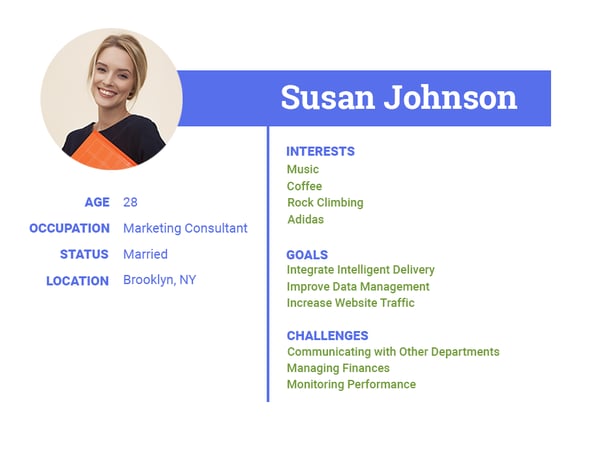
A key aspect of creating personas is defining their goals:
- What drives them?
- What challenges them?
- What do they want to achieve by communicating with your brand or purchasing your product?
Take the example of ‘Slack’. The goal of a business using Slack would be to streamline work-based communication with minimal distraction. Slack is a hub that’s made up of different channels of communication and instant messages. Therefore, the main reason why businesses would use this software is to simplify work-based communication, avoiding the need to use a more social platform, like WhatsApp, which could be super distracting… and quite unprofessional.
As well as outlining the goals of your current and prospective consumers, buyer personas will also address their potential problems and obstacles.
Consumer data is a key factor in creating accurate and valuable personas. By gathering and analysing demographic, geographic, psychographic and behavioural information, you can attain a deeper knowledge of your ideal customers; what drives them and how you can offer them what they really want.
The point of creating on-point personas is to accurately understand what to bring to market and to whom it would best suit. This way, you can target those consumers who are most likely to drive revenue and provide the most value in both the present and the future.
2. Identify touchpoints and pain points
Touchpoints
Touchpoints are points of contact between your brand and the customer - current or prospective. For example, when they connect with your ad, visit your website, contact customer support and so on. Essentially, touchpoints refer to any form of interaction between you and the customer in the stages before, during or after purchase.
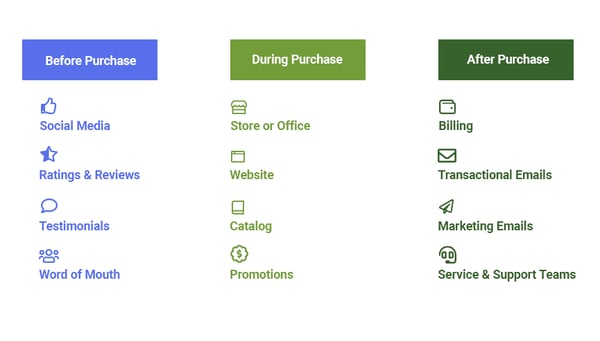
Source: SurveyMonkey
Pain Points
Pain points are essentially negative touchpoints or problems that customers experience with your brand. Pain points can range from issues customers experience with ordering a product, a lack of customer support for a problem they’ve been encountering, difficulty using your sign-up page or poor navigation of a user interface (UI), etc.
A great way to examine your customers’ pain points is by analysing your data. Look into surveys, social media or analytics software, like Google Analytics, which will detail behavioural aspects such as the points on your website where the user exited or abandoned their shopping cart.
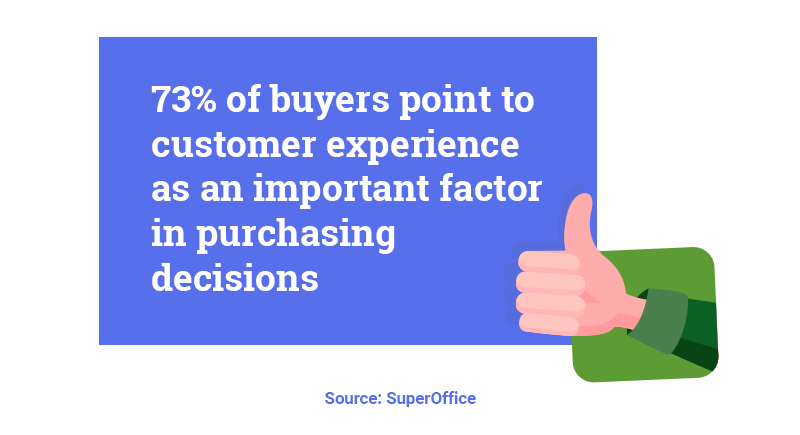
It’s no secret that some people are willing to pay more for a better experience. In fact, research shows that a massive 86% of consumers will part with their hard-earned cash in order to receive a great customer experience.
Once you get to know the intricacies of what motivates your audience, you can then easily catch each opportunity to optimise user experience (UX) and keep them satisfied. P.s. not doing this may mean that they flee to a nearby competitor who can recognise and address their touchpoints and pain points.
3. Evolve and improve
Your customers are constantly changing. But we expect that, and you can easily identify these changes by consistently analysing their demographic, geographic, psychographic and behavioural data. Don’t hesitate to distribute surveys, install analytics software, or reach out directly and ask about their experiences.
If you’re being really truthful, chances are that you’re not the same type of person you were five years ago. Perhaps you’ve changed careers, music tastes or where you live.
Let’s put you in the shoes of a hypothetical customer:
You have recently moved house and your new place is 3 hours away from where you used to live. You keep receiving push notifications telling you that your old favourite taco takeaway chain is offering a 10% discount each Thursday.
You love taco-take-away-Thursdays so this makes you reminiscent and sad. You get frustrated by these push notifications so you opt-out, eliminating the last form of personal contact that this brand has with you. Ouch.
Now consider this:
The taco take-away shop is a chain… If the chain had realised the real benefits of journey mapping earlier on, they could have analysed their customer’s data.
Doing this would have allowed them to alter their push notifications to direct the loyal customer towards promos that are active in their new geographic location. This would have retained the loyal customer and allowed the taco chain to continue gaining profit. But, alas.
By frequently analysing your data and evaluating the changes in your consumers’ lifestyles, behaviours, you will avoid the potential loss of these customers and of your brand reputation.

Essentially, you should view your customer journey map as a living entity that changes along with its audience.
Why create customer journey maps?
Customer relationships can be complicated. But customer journey mapping provides you with the foundations on which to build a deeper understanding of your users.
Whilst there are a huge number of positives when it comes to CJM, there are 3 key benefits that any brand will undoubtedly get to experience when delving into journey mapping.
1. Optimised UX
Research shows that companies using customer journey maps experience 3.5 times greater revenue from customer referrals and 24% more positive mentions on social media. Essentially, customer journey mapping lets you see things from the customer’s point of view, which then allows you to empathise and draw deeper, more accurate insights.
Empathising with your customer means that you can precisely understand and identify satisfaction levels and pain points, therefore enabling you to efficiently solve problems and innovate. For example, if your customer has difficulty navigating your app or purchasing a product, they will likely become frustrated. By analysing your data, you can identify where, when and why your customer had trouble, and react accordingly.
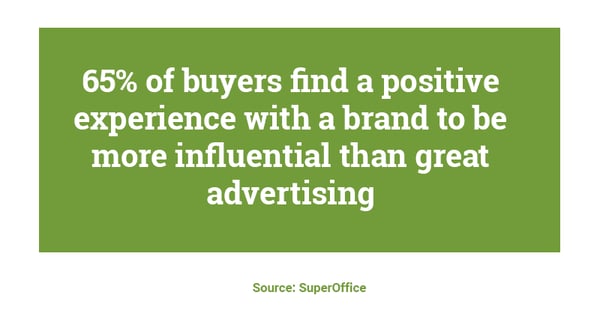
The great thing is, that once you have identified and amended these pain points, you can immediately make improvements and optimise your customer journey, making their experience as seamless as possible. The result? Your brand can enjoy strengthened and prolonged brand loyalty and the proliferation of positive WOM marketing.
2. Return on Investment (ROI)
It’s no secret that brands that better understand their customers receive higher levels of customer loyalty, competitive advantage and positive WOM. But that’s just the beginning. Including customer journey mapping in your marketing strategy can bring you that sweet cash return, i.e. a return on your marketing investment by a massive 54%! It also returns an average sales cycle that is 18x quicker than those of brands that don't use CJM. And last but certainly not least, businesses managing customer journeys experience a 21% year over year growth.
You can’t ignore those statistics.
Yes, it’s true. Brands that invest time in really getting to know their users can enjoy a greater return on investment. By ‘returns’, we don’t just mean in terms of money. Journey mapping also reduces churn, which reduces the costs of acquiring and onboarding new customers.
3. Bridging the gap between sales, marketing & more
No matter what your business, cross-departmental consistency is key.
So you’ve got your advertising and promotional tactics down to a tee and the product that you’re offering is on-point… brilliant! There’s just one issue; your customer service is weak and your sales team are disengaged with your audience. Why? Because neither of these departments have been given up-to-date information on their customers. Journey mapping alleviates these stresses by facilitating cross-departmental integrations.
We all know that things go a lot smoother when everyone’s on the same page. And journey-led transformations have been proven to increase employee engagement by up to 30%.
Without a streamlined journey map, you will surely struggle to retain valuable customers. However, by integrating the touchpoints and pain points in your journey map and sharing them across departments, the experiences of both the company and the consumers will be unparalleled.

Consistency across your departments means consistency in your brand personality, your offerings and your communications. And without a strong personality and product, your brand will lose power and retention.
Conclusion
The rise and expectation of personalised experiences means that customer journey mapping is essential to the success of businesses today. CJM provides the magnifying glass that allows you to take a deeper look into the intricacies of each consumer-brand interaction. Done well, journey mapping has the power to provide insights into your customers emotions, requirements and their potential decisions, which will enable you to streamline your marketing strategy.
Ultimately, a meticulously crafted customer journey map creates a narrative that establishes a functional visualisation of the customer experience, offering your brand direction and priceless actionable insights.
Book a free demo today to see how Hurree can help you transform your company reporting and improve your sales & marketing output 💌 Don't hesitate to get in touch via contact@hurree.co if you have any inquiries - we’re happy to chat!
Share this
You May Also Like
These Related Stories

How to Delight Your Customers Throughout The Buyer's Journey

How to Build the Perfect Customer Retention Campaign

